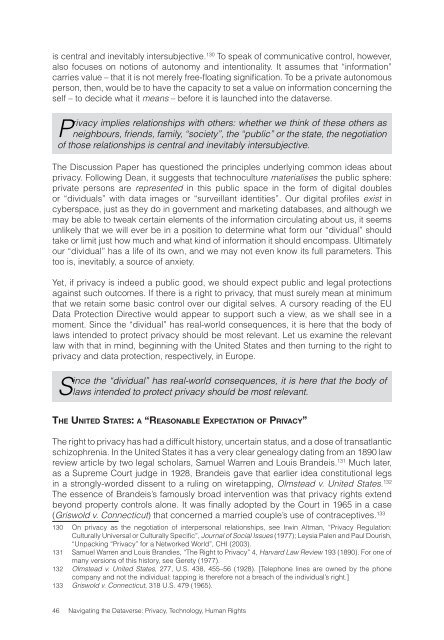Navigating the Dataverse: Privacy, Technology ... - The ICHRP
Navigating the Dataverse: Privacy, Technology ... - The ICHRP
Navigating the Dataverse: Privacy, Technology ... - The ICHRP
You also want an ePaper? Increase the reach of your titles
YUMPU automatically turns print PDFs into web optimized ePapers that Google loves.
is central and inevitably intersubjective. 130 To speak of communicative control, however,<br />
also focuses on notions of autonomy and intentionality. It assumes that “information”<br />
carries value – that it is not merely free-floating signification. To be a private autonomous<br />
person, <strong>the</strong>n, would be to have <strong>the</strong> capacity to set a value on information concerning <strong>the</strong><br />
self – to decide what it means – before it is launched into <strong>the</strong> dataverse.<br />
<strong>Privacy</strong> implies relationships with o<strong>the</strong>rs: whe<strong>the</strong>r we think of <strong>the</strong>se o<strong>the</strong>rs as<br />
neighbours, friends, family, “society”, <strong>the</strong> “public” or <strong>the</strong> state, <strong>the</strong> negotiation<br />
of those relationships is central and inevitably intersubjective.<br />
<strong>The</strong> Discussion Paper has questioned <strong>the</strong> principles underlying common ideas about<br />
privacy. Following Dean, it suggests that technoculture materialises <strong>the</strong> public sphere:<br />
private persons are represented in this public space in <strong>the</strong> form of digital doubles<br />
or “dividuals” with data images or “surveillant identities”. Our digital profiles exist in<br />
cyberspace, just as <strong>the</strong>y do in government and marketing databases, and although we<br />
may be able to tweak certain elements of <strong>the</strong> information circulating about us, it seems<br />
unlikely that we will ever be in a position to determine what form our “dividual” should<br />
take or limit just how much and what kind of information it should encompass. Ultimately<br />
our “dividual” has a life of its own, and we may not even know its full parameters. This<br />
too is, inevitably, a source of anxiety.<br />
Yet, if privacy is indeed a public good, we should expect public and legal protections<br />
against such outcomes. If <strong>the</strong>re is a right to privacy, that must surely mean at minimum<br />
that we retain some basic control over our digital selves. A cursory reading of <strong>the</strong> EU<br />
Data Protection Directive would appear to support such a view, as we shall see in a<br />
moment. Since <strong>the</strong> “dividual” has real-world consequences, it is here that <strong>the</strong> body of<br />
laws intended to protect privacy should be most relevant. Let us examine <strong>the</strong> relevant<br />
law with that in mind, beginning with <strong>the</strong> United States and <strong>the</strong>n turning to <strong>the</strong> right to<br />
privacy and data protection, respectively, in Europe.<br />
Since <strong>the</strong> “dividual” has real-world consequences, it is here that <strong>the</strong> body of<br />
laws intended to protect privacy should be most relevant.<br />
<strong>The</strong> United States: a “Reasonable Expectation of <strong>Privacy</strong>”<br />
<strong>The</strong> right to privacy has had a difficult history, uncertain status, and a dose of transatlantic<br />
schizophrenia. In <strong>the</strong> United States it has a very clear genealogy dating from an 1890 law<br />
review article by two legal scholars, Samuel Warren and Louis Brandeis. 131 Much later,<br />
as a Supreme Court judge in 1928, Brandeis gave that earlier idea constitutional legs<br />
in a strongly-worded dissent to a ruling on wiretapping, Olmstead v. United States. 132<br />
<strong>The</strong> essence of Brandeis’s famously broad intervention was that privacy rights extend<br />
beyond property controls alone. It was finally adopted by <strong>the</strong> Court in 1965 in a case<br />
(Griswold v. Connecticut) that concerned a married couple’s use of contraceptives. 133<br />
130 On privacy as <strong>the</strong> negotiation of interpersonal relationships, see Irwin Altman, “<strong>Privacy</strong> Regulation:<br />
Culturally Universal or Culturally Specific”, Journal of Social Issues (1977); Leysia Palen and Paul Dourish,<br />
“Unpacking “<strong>Privacy</strong>” for a Networked World”, CHI (2003).<br />
131 Samuel Warren and Louis Brandies, “<strong>The</strong> Right to <strong>Privacy</strong>” 4, Harvard Law Review 193 (1890). For one of<br />
many versions of this history, see Gerety (1977).<br />
132 Olmstead v. United States, 277, U.S. 438, 455–56 (1928). [Telephone lines are owned by <strong>the</strong> phone<br />
company and not <strong>the</strong> individual: tapping is <strong>the</strong>refore not a breach of <strong>the</strong> individual’s right.]<br />
133 Griswold v. Connecticut, 318 U.S. 479 (1965).<br />
46 <strong>Navigating</strong> <strong>the</strong> <strong>Dataverse</strong>: <strong>Privacy</strong>, <strong>Technology</strong>, Human Rights
















